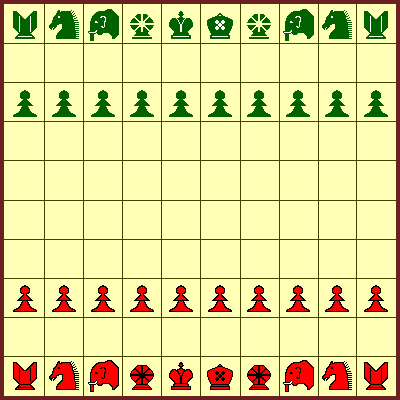Complete Chess
Shatranj at-Tamma was a sort of Shatranj played over the "decimal" board, 10x10 squares. Its name means Complete Chess.
DESCRIPTION:
In addition to the conventional Shatranj men (1 Shah, 1 Minister, 2 Elephants, 2 Horses, 2 Rukhs), the players have a pair of Dabbabas (and the corresponding Pawns). This word designated a war machine used for siege (like an onager, a sow). (It was often used in Shatranj variants, but not always with the same move).

RULES:
![]() In this game, the Dabbaba moves 1 step in all directions, like
the Shah (=King).
In this game, the Dabbaba moves 1 step in all directions, like
the Shah (=King).
There some special rules in Complete Chess:
The Pawn promotes to a Minister but only if the player has already lost his Minister. If not, the Pawn goes to the last raw, promotes to a Minister but the extant Minister is seized by the opponent.
If a Shah successes to reach the starting square of the opposing Shah, the player obtains an half-victory.
In this game, a bare Shah is not losing. He must continue to play.
HISTORY AND VARIANTS OF THIS VARIANT:
The historian al-Mas'udi (dead in 956) had mentionned a game invented before his time by al-Khalil (718-791), author of a study on harmony. He would have been the first to try improving Shatranj by adding a Camel (Jamal) on both side of the board. Nothing is knew niether of the new move nor the rules of the game. The historian told us that this variant had been abandonned.
Shatranj at-Tamma with Dabbabas reported above, was described by al-Mas‘udi and was present in all manuscript whose oldest is from 1140. However, it is most likely that their source goes up to al-‘Adli in the 9th century.
This is so far the oldest Decimal Chess recorded.
In the Shahnama (issued in 1011), the Persian poet Firdawsi told the legend of Chess invention by an Indian prince named Gaw. The poet insisted that, on ancient times, men were superior to modern men. Illustrating this fact, the poet said that their Chess were larger and more complex than those of today. They were playing on a 10x10 board with 10 Pawns and 2 Camels (Shutur) placed between Elephants and Horses.
The Camel moved on 3 squares, that meant that they jumped on the 2nd square (as the Ancient always counted the starting square). It is not said how this move was made but it seems likely that it was an "orthogonal" move along lines and columns in order to contrast with the Elephant's diagonal move.
When a Pawn was reaching the last square of a column, he promoted into a Minister that was immediately placed on an adjacent square to his Shah.

Setup of Decimal Gaw's Chess according to Firdawsi
That Complete Shatranj using the 10x10 board has got many followers. It has been an ininterrupted series of invention in Central Asia (Turkish Large Chess), India, Mongolia (Hiashatar) and Europe (Carrera, 1617).
OTHER SHATRANJ VARIANTS:





